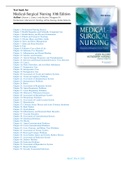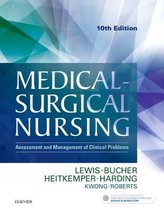Test bank for
Medical-Surgical Nursing 10th Edition
Author: Sharon L. Lewis, Linda Bucher, Margaret M.
Heitkemper, Mariann M. Harding, Jeffrey Kwong, Dottie Roberts
Chapter 1: Professional Nursing Practice
Chapter 2: Health Disparities and Culturally Competent Care
Chapter 3: Health History and Physical Examination
Chapter 4: Patient and Caregiver Teaching
Chapter 5: Chronic Illness and Older Adults
Chapter 6: Stress and Stress Management
Chapter 7: Sleep and Sleep Disorders
Chapter 8: Pain
Chapter 9: Palliative Care at End of Life
Chapter 10: Substance Use Disorders
Chapter 11: Inflammation and Wound Healing
Chapter 12: Genetics and Genomics
Chapter 13: Altered Immune Responses and Transplantation
Chapter 14: Infection and Human Immunodeficiency Virus Infection
Chapter 15: Cancer
Chapter 16: Fluid, Electrolyte, and Acid-Base Imbalances
Chapter 17: Preoperative Care
Chapter 18: Intraoperative Care
Chapter 19: Postoperative Care
Chapter 20: Assessment of Visual and Auditory Systems
Chapter 21: Visual and Auditory Problems
Chapter 22: Assessment of Integumentary System
Chapter 23: Integumentary Problems
Chapter 24: Burns
Chapter 25: Assessment of Respiratory System
Chapter 26: Upper Respiratory Problems
Chapter 27: Lower Respiratory Problems
Chapter 28: Obstructive Pulmonary Diseases
Chapter 29: Assessment of Hematologic System
Chapter 30: Hematologic Problems
Chapter 31: Assessment of Cardiovascular System
Chapter 32: Hypertension
Chapter 33: Coronary Artery Disease and Acute Coronary Syndrome
Chapter 34: Heart Failure
Chapter 35: Dysrhythmias
Chapter 36: Inflammatory and Structural Heart Disorders
Chapter 37: Vascular Disorders
Chapter 38: Assessment of Gastrointestinal System
Chapter 39: Nutritional Problems
Chapter 40: Obesity
Chapter 41: Upper Gastrointestinal Problems
Chapter 42: Lower Gastrointestinal Problems
Chapter 43: Liver, Pancreas, and Biliary Tract Problems
Chapter 44: Assessment of Urinary System
Chapter 45: Renal and Urologic Problems
Chapter 46: Acute Kidney Injury and Chronic Kidney Disease
Chapter 47: Assessment of Endocrine System
Chapter 48: Diabetes Mellitus
Chapter 49: Endocrine Problems
Chapter 50: Assessment of Reproductive System
Chapter 51: Breast Disorders
Chapter 52: Sexually Transmitted Infections
Med C File © 2022
,Chapter 53: Female Reproductive and Genital Problems
Chapter 54: Male Reproductive and Genital Problems
Chapter 55: Assessment of Nervous System
Chapter 56: Acute Intracranial Problems
Chapter 57: Stroke
Chapter 58: Chronic Neurologic Problems
Chapter 59: Dementia and Delirium
Chapter 60: Spinal Cord and Peripheral Nerve Problems
Chapter 61: Assessment of Musculoskeletal System
Chapter 62: Musculoskeletal Trauma and Orthopedic Surgery
Chapter 63: Musculoskeletal Problems
Chapter 64: Arthritis and Connective Tissue Diseases
Chapter 65: Critical Care
Chapter 66: Shock, Sepsis, and Multiple Organ Dysfunction Syndrome
Chapter 67: Acute Respiratory Failure and Acute Respiratory Distress Syndrome
Chapter 68: Emergency and Disaster Nursing
Chapter 01: Professional Nursing Practice
Lewis: Medical-Surgical Nursing, 10th Edition
MULTIPLE CHOICE
1. The nurse completes an admission database and explains that the plan of care and discharge
goals will be developed with the patient’s input. The patient states, “How is this different from
what the doctor does?” Which response would be most appropriate for the nurse to make?
a. “The role of the nurse is to administer medications and other treatments prescribed
by your doctor.”
b. “The nurse’s job is to help the doctor by collecting information and
communicating any problems that occur.”
c. “Nurses perform many of the same procedures as the doctor, but nurses are with
the patients for a longer time than the doctor.”
d. “In addition to caring for you while you are sick, the nurses will assist you to
develop an individualized plan to maintain your health.”
ANS: D
This response is consistent with the American Nurses Association (ANA) definition of
nursing, which describes the role of nurses in promoting health. The other responses describe
some of the dependent and collaborative functions of the nursing role but do not accurately
describe the nurse’s role in the health care system.
DIF: Cognitive Level: Understand (comprehension) REF: 3
TOP: Nursing Process: Implementation MSC: NCLEX: Safe and Effective Care Environment
2. The nurse describes to a student nurse how to use evidence-based practice guidelines when
caring for patients. Which statement, if made by the nurse, would be the most accurate?
a. “Inferences from clinical research studies are used as a guide.”
b. “Patient care is based on clinical judgment, experience, and traditions.”
c. “Data are evaluated to show that the patient outcomes are consistently met.”
d. “Recommendations are based on research, clinical expertise, and patient
preferences.”
ANS: D
Evidence-based practice (EBP) is the use of the best research-based evidence combined with
Med C File © 2022
,clinician expertise. Clinical judgment based on the nurse’s clinical experience is part of EBP,
but clinical decision making should also incorporate current research and research-based
guidelines. Evaluation of patient outcomes is important, but interventions should be based on
research from randomized control studies with a large number of subjects.
Med C File © 2022
, DIF: Cognitive Level: Remember (knowledge) REF: 15
TOP: Nursing Process: Planning MSC: NCLEX: Safe and Effective Care Environment
3. The nurse teaches a student nurse about how to apply the nursing process when providing
patient care. Which statement, if made by the student nurse, indicates that teaching was
successful?
a. “The nursing process is a scientific-based method of diagnosing the patient’s
health care problems.”
b. “The nursing process is a problem-solving tool used to identify and treat patients’
health care needs.”
c. “The nursing process is used primarily to explain nursing interventions to other
health care professionals.”
d. “The nursing process is based on nursing theory that incorporates the
biopsychosocial nature of humans.”
ANS: B
The nursing process is a problem-solving approach to the identification and treatment of
patients’ problems. Diagnosis is only one phase of the nursing process. The primary use of the
nursing process is in patient care, not to establish nursing theory or explain nursing
interventions to other health care professionals.
DIF: Cognitive Level: Understand (comprehension) REF: 5
TOP: Nursing Process: Implementation MSC: NCLEX: Safe and Effective Care Environment
4. A patient has been admitted to the hospital for surgery and tells the nurse, “I do not feel
comfortable leaving my children with my parents.” Which action should the nurse take next?
a. Reassure the patient that these feelings are common for parents.
b. Have the patient call the children to ensure that they are doing well.
c. Gather more data about the patient’s feelings about the child-care arrangements.
d. Call the patient’s parents to determine whether adequate child care is being
provided.
ANS: C
Because a complete assessment is necessary in order to identify a problem and choose an
appropriate intervention, the nurse’s first action should be to obtain more information. The
other actions may be appropriate, but more assessment is needed before the best intervention
can be chosen.
DIF: Cognitive Level: Apply (application) REF: 6
OBJ: Special Questions: Prioritization TOP: Nursing Process: Assessment
MSC: NCLEX: Psychosocial Integrity
5. A patient who is paralyzed on the left side of the body after a stroke develops a pressure ulcer
on the left hip. Which nursing diagnosis is most appropriate?
a. Impaired physical mobility related to left-sided paralysis
b. Risk for impaired tissue integrity related to left-sided weakness
c. Impaired skin integrity related to altered circulation and pressure
d. Ineffective tissue perfusion related to inability to move independently
ANS: C
The patient’s major problem is the impaired skin integrity as demonstrated by the presence of
a pressure ulcer. The nurse is able to treat the cause of altered circulation and pressure by
frequently repositioning the patient. Although left-sided weakness is a problem for the patient,
Med C File © 2022






